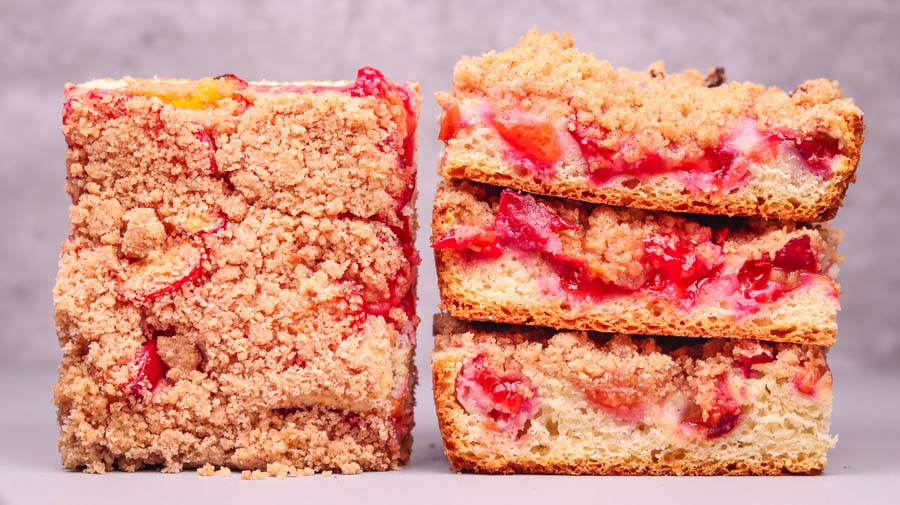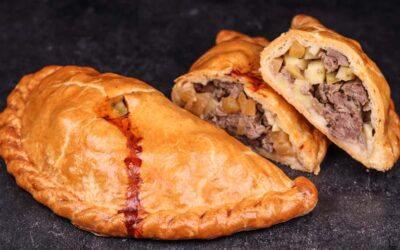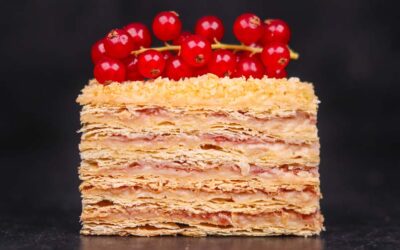This cake is an awesome summer treat. I only found out about its existence very recently when someone in the comments section of my brioche cake video told me about it. They said that the brioche cake kind of resembles it. And I do agree, they look similar and the principles of making them are alike too.
But while on the surface both cakes can seem like each other, they are very different in some great ways. For one this recipe is far simpler and quicker than the brioche. Secondly it is much fruitier and juicier because the dough to fruit ratio here is far higher. And subsequently it will stay juicy for longer than the brioche ever could.
It kind of looks like I’m saying that this is better, but I don’t really like to do that very often. There is no such thing as better or worse when it comes to good recipes. They’re both great in their own right and both are worth a try. Even the brioche could be modified to resemble this plum cake a bit more closely and vice versa. Baking is all about experimentation. At the end of the day, it is up to the person eating it to judge it.
Speaking of adjustments and experiments, this is probably not an authentic version of zwetschgenkuchen, but the principle is the same. If you have watched the channel for a while, you’ll know that I make my recipes in a certain style, and I use the ingredients that are available to me. I’m not here to stick to traditions or to impress anyone. I just like baking and that’s all.
This recipe makes two 22cm (8.5in) x 16.5cm (6.5in) cakes. You can use a large baking tray to make one big cake.
Watch the video down below for detailed instructions.
Ingredients
For the dough –
250g (8.8oz) white bread flour
30g (1oz) sugar
3g (0.1oz) salt
5g (0.17oz) instant dry yeast or 6g (0.21oz) active dry yeast or 15g (0.53oz) fresh yeast
70g (2.45oz) softened butter
1 medium egg (50g; 1.75oz)
8g (0.3oz) vanilla paste
110g (3.9oz) milk
600g (1.3lb) plums with the stones removed
For the streusel –
100g (3.5oz) flour
50g (1.75oz) sugar
4g (0.14oz) cinnamon
1g (0.035oz) salt
60g (2.1oz) cold butter
To learn more about no-knead dough temperature control click here.
The flour I use has a protein content of 13%. If your flour is weaker, then you may need to lower the hydration.
If you are using active dry yeast, then you may need to let it sit in the milk for 10 minutes before adding the other ingredients or else it could take a lot longer to raise the dough.
If you are curious about why the dough contains butter, egg, and sugar, click the links to learn more about the effects those ingredients have on bread dough.
Method
- Make the streusel. Combine the flour, salt, cinnamon, and sugar. Mix well. Add the cold butter and rub the mix to a uniform crumble. It should resemble wet sand when it’s done.
- Make the dough. In a large bowl combine the milk, yeast, salt, sugar, egg, and vanilla paste. Mix well to dissolve the salt and sugar completely. Add 4 tablespoons of the flour and mix to a smooth paste. Add the softened butter and mix again.
- Finally, add the remaining flour and mix until there is no dry flour left. *Desired dough temperature around 25C (77F). If your dough is warmer, then it will ferment more rapidly. If it is cooler, then it will take longer. Adjust proofing time accordingly.
- Bulk ferment for 1.5 hours or until the dough has doubled in size.
- Spread the dough onto a greased baking tray. Top with plums. Cover so the flies won’t attack it!
- Final proof for 1 hour. During this time pre-heat the oven to 170C (340F) fan on.
- Sprinkle the streusel over the plums in an even layer.
- Bake the cake for 40 minutes turning it halfway through the bake.
- Leave to set for 15 minutes before removing it from the baking tray.
This cake is so juicy that it will still be nice and moist on the next day, so you can easily prepare it ahead of time.
Keep in mind that the conditions in each kitchen are different, so fermentation times may vary for you. It is up to the baker to control the bread and react accordingly.
Your oven may be different too, so your baking time may vary.
Watch The Video Here



